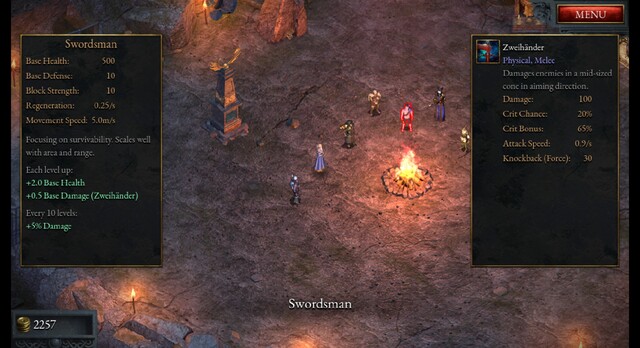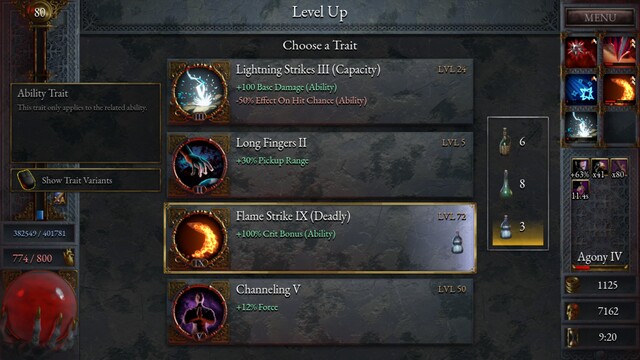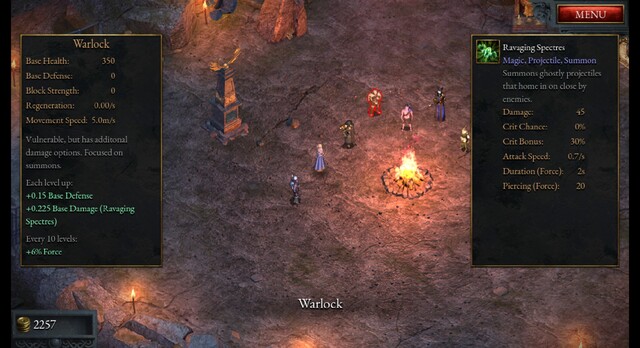Slay hordes of terrifying monsters in this horde survival roguelite. Descend into the Halls of Torment where the Lords of the underworld await you… How long can you survive?
— the Steam store page description
Halls of Torment is a self-described “horde survival roguelite” game. I would instead describe it as a roguelite game with danmaku shoot-em-up mechanics (also known as bullet hell or heaven). Each map (“Hall”) is played for a set amount of time (30 minutes) before the final boss of the level spawns.
Halls of Torment bears a strong semblance to 90s-2000s era computer roleplaying games (cRPG). During which, many games used 2D pre-rendered sprites created from 3D models. In this case, the reasons are artistic as opposed to technical.
A few notes about this review:
- I received this game as a gift during the Spring Sale on Steam from a friend met in real life who is unlikely to have any affiliation with the developers.
- the game was in early access when I played
- Damage, other character stats, and balance may have changed.
- I collected 300+ achievements because the developers made every
quest an achievement.
- this also means I played through the game multiple times.
Game Design
What makes this game like Rogue: the player character’s level and abilities reset upon visiting a Hall. (Level ups are not persistent.)
What makes the game not like Rogue: after successfully defeating the boss of the Hall, the player character returns to the encampment and brings back empty bottles (and herbs) collected during the run. Additionally, each Hall has a well to which equipment can be dropped and retrieved at camp. The gold earned during the course of the run is also spent at a shrine that grants blessings. (There are some elements of persistent progress.)
In Halls of Torment, there are only five Halls. The reasons to replay are trying different characters and completing quests. (All quests are basically milestones and challenges. For example, “reach level 30 while playing as the specified character” or “deal x amount of damage while completing y condition”.)
- Haunted Caverns
- Ember Grounds (the red level)
- Forgotten Viaduct (green level)
- Frozen Depths (blue level)
- Chamber of Dissonance (magenta level), looks a lot like a Path of Exile map
Each Hall is unlocked one after the other. However, I had a very hard time beating the final boss of the first level compared to completing the second level entirely. After completing all five Halls, Agony Mode (hard difficulty with performance-based scaling) unlocks.
Over the course of the player characters’ adventures, two NPCs are rescued The Wellkeeper and The Cupbearer. The Wellkeeper retrieves equipment thrown down wells, and The Cupbearer mixes potions which affects rolls on scrolls, level-ups and chests.
Within a Hall, when the player picks up a scroll, the game presents three choices randomly picked from a pool of abilities. The potions brewed by the Cupbearer can reroll the choices. All characters have access to the same pool of abilities.
A similar mechanic is in place for level ups. Upon level up, the game presents four traits. Using potions, traits can be rerolled, augmented, or banned for a limited amount of times per run.
My Playthrough
I generally played one character at a time. I picked one character then went to each Hall with the goal of completing all quests (which involves completing a Hall on Agony Mode).
The exception was at the beginning of the game where I played Swordsman, the only character initially available. Out of preference, I switched to Ranger to beat the first Hall. Then, played the Cleric to unlock and beat the rest of the Halls. As my save file developed, I started skipping Halls on the later characters I played.
Player Characters
The main difference between characters is their stats and default attack.
Swordsman
The Swordsman is the first character available. His weapon is a zweihander (two-handed sword) though his attack appears to be a shockwave. With enough level ups and bonuses to range, the “shockwaves” travel fair distances.
Archer
The Archer, a woman with a bow, is the second character unlocked. I switched to her just for the extra range on her default attack. I had a rough time beating the final boss of the first level.
The First Boss of Halls of TormentCleric
The thought process behind the balance is mystery. The Cleric deals 2000 damage on her default attack which is a short-ranged spell with a wide arc and a chance on hit to apply debuffs to whatever survives. She also has high health regeneration. I had a much easier time completing the rest of the game than I did beating the first level with the Archer.
Warlock
I had tried to play this character when I first unlocked him. Between a Cleric and a Warlock, a Warlock that summons specters and trades health/defense for more damage just sounded cooler. (Specters are like bat-shaped green fireballs that track.) His default attack deals 45 damage which was insanely weak for the third Hall. I had given him one try and didn’t end up killing anything on Forgotten Viaduct (normal difficulty). So I was curious to see how this character could be played viably.
After playing through all Halls as the Cleric, I put the equipment I collected on the Warlock (and bought all Shrine Blessings available) to see if he would have an easier time fighting in the Halls which he did. So it seems, items that help health regeneration and damage go a long way. But the equipment I gave him ended up being similar to the equipment I gave other characters for subsequent runs.
Norseman
The Norseman was the first character I played to have a secondary attack (Frost Nova) that triggers after inflicting a certain amount of damage with his main attack. Most of his quests are related to ice magic and chilling debuffs. I notice, overall, there aren’t as many frost-related effects as there are fire.
Ice:
- Avalanche
- Hailstorm, more effort to use than most other spells
- Frost Strike (Fire Strike, an upgrade converts the element to Frost)
- Ring of Frost
- Frost Dragon’s Helmet
Fire:
- Meteor Strike
- Fire Strike
- Dragon’s Breath
- Blazing Shell (chestpiece)
- Sparking Tips (gloves)
- Ring of Fire (jewelry)
- Lightning Strike, with Explosive Strikes upgrade
- Radiant Aura, with Sacred Flame ugprade
Landsknecht
The Landsknecht is a strange anachronistic character. From what I can tell, she wields a high caliber rifle. Her gun has no spread, but she throws grenades.
Many traits upon level up trade rifle damage for grenade damage (single target vs area-of-effect). Generally, I had stuck to keeping her rifle damage and increasing her rate of fire (and rate of grenade throwing). The rifle nearly one shots bosses.
Sage
The Sage has no default attacks and relies entirely on spells. (There is at least one tome at the start of every Hall.) The perk about him is that all ability scrolls that would have appeared in a Hall are instead tomes. Therefore, he can select abilities deterministically.
Others
For these characters, I don’t have much commentary, either for the lack of distinction or the lack of challenge. The later characters I played went straight to Agony Mode because of the equipment and Shrine Blessings I accumulated.
- Sorceress, appears to be inclined to lightning damage
- Exterminator, uses a flamethrower
- Shield Maiden
- Huntress
I barely touched map interactables
Halls may have interactables scattered around the map. A category of interactables are tomes which describe an objective that leads to an advantage in a boss fight. However, I had ignored them, and incidentally completed one of the objectives.
In Forgotten Viaduct, I had arbitrarily picked a direction in which to walk just to see what would happen. There are two regiments of green ghosts that slowly walk from both ends of the map, and I wanted to see what would happen if I went past them. (They’ll keep going and ignore the player.)
I ran in a single direction for the rest of the map and eventually found a tomb. Breaking the tomb yields a Sentinel Orb which disables the invulnerability phase of the boss fight.
I had ignored most of the interactables as the game doesn’t have the atmosphere or pace to warrant staying in one place and reading. Halls of Torment will at least pause the scene to display the contents of interactables in the world. Not until after I completed most of the game did I bother to find and read some of them.
Broadly, in isometric hack-and-slash roleplaying games, from Diablo to Path of Exile to Halls of Torment, the lore is revealed through interactables scattered on the map. It is not the case for Halls of Torment, or rather, the word count within the interactable in much lower.
Overall Opinion
- this game uses the Godot Engine, an MIT-licensed cross platform game engine, there is almost nothing technical to complain about other than the game crashing occasionally.
Halls of Torment is an indie game that fits within a short play session. While the game aims to be replayable by having unlocks behind different character classes, there is not much variety behind the maps beyond visual theme. The characters, having the same pool of abilities, can also play similarly. After playing to collect all achievements (310/310 after 80 hours total playtime), the game became repetitive. I think the game could use content that expounds upon the setting, a different objective, change of pace, or steer towards its millenial cRPG influences. But one can also argue that given the scale, budget, or price of the indie game, it does what it intended to do well enough.
The game has a nifty roster of spells each with two to three quirky upgrades. My favorite is Lightning Strikes upgraded to cause explosions on hit. However, owing to shoot-em up influences, nearly all spells are auto-cast and don’t involve aiming or contouring by the player (with the exception of Hailstorm).
As of June 23 (2024), the game is still in early access. I may revisit the game and update the review for the final release.









